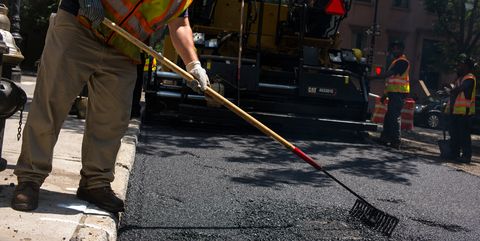What Happened To The Previous Gas Taxes For Road Repair?

Robert Nickelsberg/Getty Images Automobile and Driver
The demand to repair America's roads and bridges keeps growing while revenue, primarily from taxes on fuel sales, has been dropping, mostly because cars have get more fuel-efficient. The shrinking revenue all the same goes toward repairing the roads, just federal and state income oasis't kept up. These taxes are generally fixed rates rather than a percent per-gallon, and therefore don't rise with inflation.
Since the federal gas revenue enhancement was last increased in 1993, the fuel economic system of new passenger vehicles has improved from an boilerplate twenty.5 mpg to over 26 mpg, co-ordinate to the U.S. Department of Energy. Although the number of cars and the total miles driven have risen, annual revenues from the federal excise tax on fuel have been declining since 2007.
The same is happening with state fuel taxes, of course, just many states have started to adapt to this; 27 take either raised or reformed their gas taxes since 2013, and road repair is a hot topic for candidates running for state office this election season.
In Iowa, a x-cent-per-gallon hike enacted in 2015 has already stepped upwards the timelines for hundreds of state projects. And Georgia'southward system links its gas tax to aggrandizement. (The alternative of taxing as a pct of the sales toll has been widely rejected because information technology would make revenues equally volatile as gas prices; it'south hard to plan infrastructure spending for years in advance if you can't reliably projection the income.) Thruway funds also have proven easy for legislators to raid to cover budget gaps elsewhere. On the other manus, some states such as Oklahoma have repeatedly diverted general-fund coin to fix roads. Oklahoma recently raised its gas taxation, nevertheless, using the equivalent corporeality formerly drawn from the full general fund to give teachers a raise. Other states are moving to foreclose raids, designating gas tax funds for transportation spending only.
The need to repair and upgrade infrastructure across America is clear, and it's one of the few governmental priorities that a majority of both Republican and Democratic voters agree upon. The American Society of Civil Engineers gives our roadway infrastructure a class of D, for poor. "Currently, 32 percent of America's major roads are in poor or mediocre condition," the ASCE said in its 2013 report carte. Most half—47 percent—of miles traveled are on urban roads that the grouping classifies every bit poor. Such degraded pavement costs the average motorist $324 a year in repairs and operating costs, totaling $67 billion per year, money that might be ameliorate spent on fixing the roads rather than our cars.
Few states have done much to address a seeming inevitability: the tiny only fast-rising proportion of electrical vehicles, which pay no gasoline tax toward road repair and yet have been subsidized with rebates to buyers on the federal level and in many states. Just 19 states take enacted EV fees to help pay for roads, with Georgia charging the near. Pay-per-mile scenarios like the one in Oregon (thus far voluntary, with a corresponding rebate to cover taxes drivers pay at the pump) rail vehicle mileage, substantially making every road a cost route. This is seen as one way to refill road-fund coffers and level out the cost-sharing between gasoline and electric cars. Another arroyo is to raise registration and licensing fees to cover route maintenance costs, another ways of sharing the brunt irrespective of the free energy source propelling the machine.
The mother ship, the federal Highway Trust Fund, is expected to be insolvent past 2021, however. The federal excise tax on gas has been fixed at 18.four cents per gallon (24.4 cents for diesel fuel) since 1993. In their 2016 election campaigns, both presidential candidates promised to fix America's infrastructure, with Democrat Hillary Clinton pledging to add $275 billion in spending, an amount President Donald Trump doubled with a $550 billion pledge (sometimes, he even said he'd invest $i trillion, though a large part would get toward upgrading other infrastructure, such every bit water and sewer systems). Politifact rates that hope equally "stalled," despite the president's efforts then far.
In February, simply as he was announcing a $200 billion 2018 infrastructure spending plan, President Trump endorsed a 25-cent-per-gallon increment to support future expenditures—cartoon much opposition from his political party. And then nothing came of that proposal. The clock is ticking and roads are like our cars—the longer maintenance is deferred, the more information technology costs in the end.
This content is created and maintained by a 3rd political party, and imported onto this page to help users provide their email addresses. You lot may be able to discover more information nearly this and similar content at pianoforte.io
Source: https://www.caranddriver.com/features/a23582369/gas-tax-insufficient-fix-roads/
Posted by: yatescoultan.blogspot.com



0 Response to "What Happened To The Previous Gas Taxes For Road Repair?"
Post a Comment